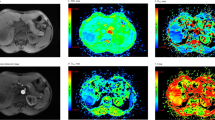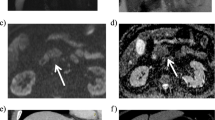Abstract
Objective
To investigate the value of intravoxel incoherent motion diffusion-weighed magnetic resonance imaging (IVIM-DWI) in discriminating the pathological grades of hilar cholangiocarcinoma (HC).
Patients and methods
Thirty-seven HC patients were enrolled and received routine and advanced DWI scanning with multiple b-values. IVIM-DWI images were obtained using echo-planar imaging sequence.
Results
The consistency of the maximum cross-sectional area ROI measuring method was higher than that of the repeated sampling ROI measuring method. ADCslow values were closely correlated with the pathological grades of HC. The degrees of biliary dilatation and MELD scores had no influence on the negative correlation between ADCslow values and the pathological degrees of HC patients.
Conclusions
ADCslow values could be applied in indicating the pathological grades of HC, which was independent on the extent of biliary dilatation.





Similar content being viewed by others
References
Nakanuma, Y., et al., Pathological classification of intrahepatic cholangiocarcinoma based on a new concept. World J Hepatol, 2010. 2(12): p. 419-27.
Andersen, J.B., et al., Genomic and genetic characterization of cholangiocarcinoma identifies therapeutic targets for tyrosine kinase inhibitors. Gastroenterology, 2012. 142(4): p. 1021–1031 e15.
Andersen, J.B. and S.S. Thorgeirsson, Genetic profiling of intrahepatic cholangiocarcinoma. Curr Opin Gastroenterol, 2012. 28(3): p. 266-72.
Xie, D., et al., Genetic profiling of intrahepatic cholangiocarcinoma and its clinical implication in targeted therapy. Am J Cancer Res, 2016. 6(3): p. 577-86.
Wang, W., et al., Laparoscopic surgery and robotic surgery for hilar cholangiocarcinoma: an updated systematic review. ANZ J Surg, 2020.
Mizuno, T., T. Ebata, and M. Nagino, Advanced hilar cholangiocarcinoma: An aggressive surgical approach for the treatment of advanced hilar cholangiocarcinoma: Perioperative management, extended procedures, and multidisciplinary approaches. Surg Oncol, 2020. 33: p. 201-206.
Liu, S., et al., Wip1 is associated with tumorigenity and metastasis through MMP-2 in human intrahepatic cholangiocarcinoma. Oncotarget, 2017. 8(34): p. 56672-56683.
Liu, S., et al., iNOS is associated with tumorigenicity as an independent prognosticator in human intrahepatic cholangiocarcinoma. Cancer Manag Res, 2019. 11: p. 8005-8022.
Staub, J., et al., Unilateral versus bilateral hilar stents for the treatment of cholangiocarcinoma: a multicenter international study. Ann Gastroenterol, 2020. 33(2): p. 202-209.
Abdel Razek, A.A.K., Routine and Advanced Diffusion Imaging Modules of the Salivary Glands. Neuroimaging Clin N Am, 2018. 28(2): p. 245–254.
Razek, A., Editorial for “Preliminary Assessment of Intravoxel Incoherent Motion Diffusion‐Weighted MRI ( IVIM‐DWI ) Metrics in Alzheimer's Disease”. Journal of Magnetic Resonance Imaging, 2020. 52.
Mao, X., et al., Quantitative evaluation of intravoxel incoherent motion diffusion-weighted imaging (IVIM) for differential diagnosis and grading prediction of benign and malignant breast lesions. Medicine (Baltimore), 2018. 97(26): p. e11109.
Ma, W., et al., Quantitative parameters of intravoxel incoherent motion diffusion weighted imaging (IVIM-DWI): potential application in predicting pathological grades of pancreatic ductal adenocarcinoma. Quant Imaging Med Surg, 2018. 8(3): p. 301-310.
Chow, A.M., et al., Liver fibrosis: An intravoxel incoherent motion (IVIM) study. Journal of Magnetic Resonance Imaging Jmri, 2012. 36(1): p. 159-167.
Zhang, B., et al., Intravoxel Incoherent Motion MR Imaging for Staging of Hepatic Fibrosis. PLoS One, 2016. 11(1): p. e0147789.
A, L., et al., Liver cirrhosis: intravoxel incoherent motion MR imaging——pilot study. Radiology, 2008. 249(3): p. 891.
Patel, J., et al., Diagnosis of cirrhosis with intravoxel incoherent motion diffusion MRI and dynamic contrast-enhanced MRI alone and in combination: preliminary experience. Journal of Magnetic Resonance Imaging Jmri, 2010. 31(3): p. 589-600.
Shintaro Ichikawa, M.D., et al., Intravoxel incoherent motion imaging of focal hepatic lesions. Journal of Magnetic Resonance Imaging Jmri, 2013. 37(6): p. 1371-1376.
Andreou, A., et al., Measurement reproducibility of perfusion fraction and pseudodiffusion coefficient derived by intravoxel incoherent motion diffusion-weighted MR imaging in normal liver and metastases. Eur Radiol, 2013. 23(2): p. 428-434.
Yoon, J.H., et al., Evaluation of hepatic focal lesions using diffusion-weighted MR imaging: comparison of apparent diffusion coefficient and intravoxel incoherent motion-derived parameters. Journal of Magnetic Resonance Imaging, 2014. 39(2): p. 276–285.
Xu, X. and X. Zhang, The Application of Intravoxel Incoherent Motion Diffusion-Weighted Imaging in the Diagnosis of Hilar Obstructive Jaundice. J Comput Assist Tomogr, 2019. 43(2): p. 228-234.
Le Bihan, D., et al., Separation of diffusion and perfusion in intravoxel incoherent motion MR imaging. Radiology, 1988. 168(2): p. 497-505.
Le Fur, M., et al., Toward Molecular Imaging of Intestinal Pathology. Inflamm Bowel Dis, 2020.
Zamboni, G.A., et al., Optimum imaging of chronic pancreatitis. Abdom Radiol (NY), 2020. 45(5): p. 1410-1419.
Liang, J., et al., Using IVIM-MRI and R2 Mapping to Differentiate Early Stage Liver Fibrosis in a Rat Model of Radiation-Induced Liver Fibrosis. Biomed Res Int, 2018. 2018: p. 4673814.
Shin, H.J., et al., Liver intravoxel incoherent motion diffusion-weighted imaging for the assessment of hepatic steatosis and fibrosis in children. World J Gastroenterol, 2018. 24(27): p. 3013-3020.
Patella, F., et al., Quantification of heterogeneity to classify benign parotid tumors: a feasibility study on most frequent histotypes. Future Oncol, 2020. 16(12): p. 763-778.
Bohara, M., et al., Histological Grade of Meningioma: Prediction by Intravoxel Incoherent Motion Histogram Parameters. Acad Radiol, 2020. 27(3): p. 342-353.
Razek, A.A., A. Fathy, and T.A. Gawad, Correlation of apparent diffusion coefficient value with prognostic parameters of lung cancer. J Comput Assist Tomogr, 2011. 35(2): p. 248-52.
Abdel Razek, A.A., et al., Correlation of apparent diffusion coefficient at 3T with prognostic parameters of retinoblastoma. AJNR Am J Neuroradiol, 2012. 33(5): p. 944-8.
Wei, Y., et al., Intrahepatic cholangiocarcinoma in the setting of HBV-related cirrhosis: Differentiation with hepatocellular carcinoma by using Intravoxel incoherent motion diffusion-weighted MR imaging. Oncotarget, 2018. 9(8): p. 7975-7983.
Jerjir, N., et al., Intravoxel incoherent motion and dynamic contrast-enhanced MRI for differentiation between hepatocellular adenoma and focal nodular hyperplasia. The British Journal of Radiology, 2017. 90: p. 20170007.
Meng, M., et al., A novel approach to monitoring the efficacy of anti-tumor treatments in animal models: combining functional MRI and texture analysis. BMC Cancer, 2018. 18(1): p. 833.
Zhu, S., et al., Esophageal carcinoma: Intravoxel incoherent motion diffusion-weighted MRI parameters and histopathological correlations. J Magn Reson Imaging, 2019. 49(1): p. 253-261.
Xu, X., L. Li, and X.N. Zhang, Correlation analysis of preoperative magnetic resonance cholangiopancreatography and prognosis in hilar cholangiocarcinoma. Clin Invest Med, 2019. 42(4): p. E14-E21.
Author information
Authors and Affiliations
Corresponding author
Ethics declarations
Conflict of interest
The authors declare that there is no conflict of interest.
Ethical approval
The study was approved by the Ethics Committee of the Institution of Tianjin Hospital of ITCWM, Nankai Hospital, and was conducted in accordance with the 1975 Declaration of Helsinki.
Additional information
Publisher's Note
Springer Nature remains neutral with regard to jurisdictional claims in published maps and institutional affiliations.
Rights and permissions
About this article
Cite this article
Xu, X. Diagnosis of hilar cholangiocarcinoma using intravoxel incoherent motion diffusion-weighted magnetic resonance imaging. Abdom Radiol 46, 3159–3167 (2021). https://doi.org/10.1007/s00261-021-02997-x
Received:
Revised:
Accepted:
Published:
Issue Date:
DOI: https://doi.org/10.1007/s00261-021-02997-x




